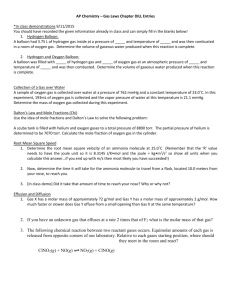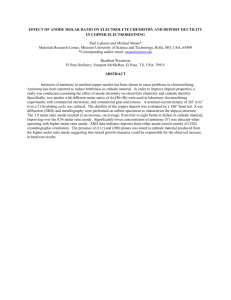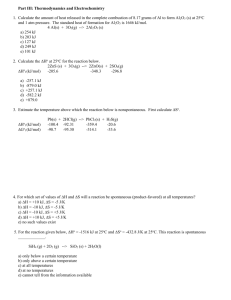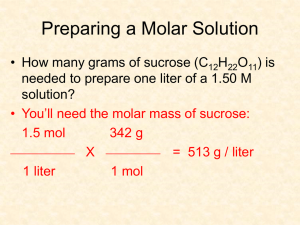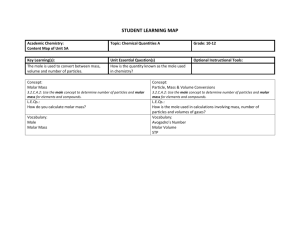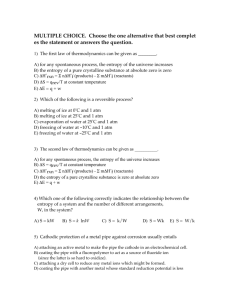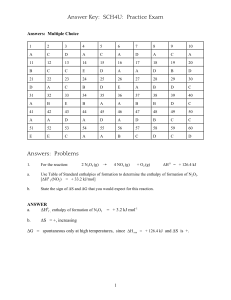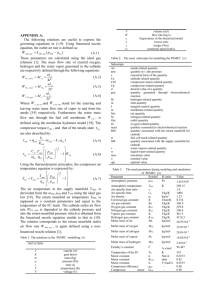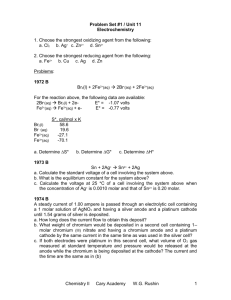ELECTROCHEMISTRY A. Mg + AgNO3 à Mg(NO3)2 + Ag I. What is
advertisement
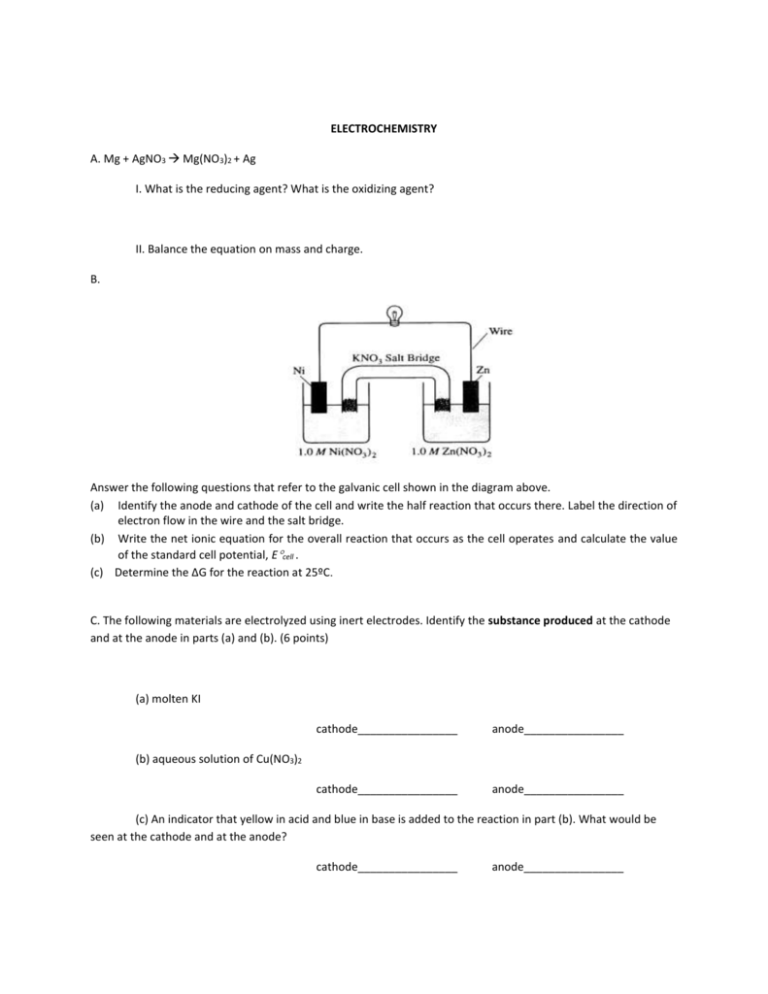
ELECTROCHEMISTRY A. Mg + AgNO3 Mg(NO3)2 + Ag I. What is the reducing agent? What is the oxidizing agent? II. Balance the equation on mass and charge. B. Answer the following questions that refer to the galvanic cell shown in the diagram above. (a) Identify the anode and cathode of the cell and write the half reaction that occurs there. Label the direction of electron flow in the wire and the salt bridge. (b) Write the net ionic equation for the overall reaction that occurs as the cell operates and calculate the value of the standard cell potential, Ecell . (c) Determine the ∆G for the reaction at 25ºC. C. The following materials are electrolyzed using inert electrodes. Identify the substance produced at the cathode and at the anode in parts (a) and (b). (6 points) (a) molten KI cathode________________ anode________________ cathode________________ anode________________ (b) aqueous solution of Cu(NO3)2 (c) An indicator that yellow in acid and blue in base is added to the reaction in part (b). What would be seen at the cathode and at the anode? cathode________________ anode________________ THERMODYNAMICS A. Calculate the Gibbs free energy (G) at 35°C for a reaction where the H = -98.4 kJ and S = - 411 J/K for this reaction. Is this reaction spontaneous at this temperature? B. Use the table of bond enthalpies below to calculate the enthalpy of reaction for the reaction shown below. Also use your thermodynamic chart and heats of formation to calculate the value for the enthalpy. Compare the answers. CO(g) + C-O 358 kJ/mol C=O 799 kJ/mol C≡O 1072 kJ/mol O=O 1 2 O2(g) CO2(g) 495 /mol B. A 6.77 gram sample of methane is burned in a bomb (constant volume) calorimeter whose total heat capacity is 5.864 kJ/◦C. The temperature rises from 14.5◦C to 67.0◦C. Calculate the heat per gram for the combustion of methane. CH4(g) + 2 O2(g) CO2(g) + 2 H2O(l) C. Given the following reactions, determine the heat of formation of VCl3. V(s)+ 2 Cl2(g) VCl4(l) H = -569.4 kJ VCl3(s) VCl2(s) + ½ Cl2(g) H = +128.9 kJ 2 VCl3(s) VCl2(s) + VCl4(l) H = +140.2 kJ KINETICS Graphical methods are frequently used to analyze data and obtain desired quantities. (a) 2 HI(g) 2(g) + I2(g) The following data give the value of the rate constant at various temperatures for the gas phase reaction above. T (K) 647 666 683 700 716 k (litre/mol sec) -5 -4 -4 -3 -3 Describe, without doing any calculations, how a graphical method can be used to obtain the activation energy for this reaction. (b) A(g) (g) + C(g) The following data give the partial reaction above. PA (mm Hg) 348 247 185 105 58 t (sec) 0 600 1200 2400 3600 Describe, without doing any calculations, how graphs can be used to determine whether this reaction is first or second order in A and how these graphs are used to determine the rate constant. 1984 B obtained. All measurements were made at the same temperature. Initial Rate of Formation of Z, (mol.L-1.sec-1) -4 -3 -3 -3 (a) (b) (c) (d) Initial [X]o, (mol.L-1) 0.20 0.40 0.40 0.60 Initial [Y]o, (mol.L-1) 0.10 0.20 0.40 0.60 Give the rate law for this reaction from the data above. Calculate the specific rate constant for this reaction and specify its units. How long must the reaction proceed to produce a concentration of Z equal to 0.20 molar, if the initial reaction concentrations are [X]o = 0.80 molar, [Y]o = 0.60 molar and [Z]0 = 0 molar? Select from the mechanisms below the one most consistent with the observed data, and explain your choice. In these mechanisms M and N are reaction intermediates. (1) (slow) (fast) (2) (fast) (slow) (3) (slow) (fast) (fast) PERIODIC TRENDS 1973 D First ionization Energy (kilocalories/mole) Covalent Radii, Å Li 124 1.34 Be 215 0.90 B 191 0.82 C 260 0.77 N 336 0.75 O 314 0.73 F 402 0.72 The covalent radii decrease regularly from Li to F, whereas the first ionization energies do not. For the ionization energies, show how currently accepted theoretical concepts can be used to explain the general trend and the two discontinuities. 1977 D The electron affinities of five elements are given below. 13Al 12 kcal/mole 14Si 32 kcal/mole 15P 17 kcal/mole 16S 48 kcal/mole 17Cl 87 kcal/mole Define the term “electron affinity” of an atom. For the elements listed above, explain the observed trend with the increase in atomic number. Account for the discontinuity that occurs at phosphorus. 1984 D Discuss some differences in physical and chemical properties of metals and nonmetals. What characteristic of the electronic configuration of atoms distinguishes metals from nonmetals. On the basis of this characteristic explain why there are many more metals than nonmetals. 1985 D Properties of the chemical elements often show regular variation with respect to their positions in the periodic table. (a) (b) (c) Describe the general trend in acid-base character of the oxides of the elements in the third period (Na to Ar). Give examples of one acidic oxide and one basic oxide and show with equations how these oxides react with water. How does the oxidizing strength of the halogen elements vary down the group? Account for this trend. How does the reducing strength of the alkali metals vary down the group? Account for this trend. LIQUIDS, SOLIDS, and SOLUTIONS 1980 D Account for the differences in solubility described in each of the following experimental observations: (a) BaCO3, BaSO3, and BaSO4 are only slightly soluble in water, but the first two dissolve in HCl solution whereas BaSO4 does not. (b) CuS cannot be dissolved by warm dilute HCl but it does dissolve in warm dilute HNO3. (c) AgCl, Hg2Cl2 and PbCl2 are only slightly soluble in water, but AgCl does dissolve in ammonia solution whereas the other two do not. (d) Fe(OH)3 and Al(OH)3 are only slightly soluble in water, but Al(OH) 3 dissolves in concentrated NaOH whereas Fe(OH)3 does not. 1984 C Give a scientific explanation for the following observations. Use equations or diagrams if they are relevant. (a) (b) (c) (d) It takes longer to cook an egg until it is hard-boiled in Denver (altitude 1 mile above sea level) than it does in New York City (near sea level). Burn coal containing a significant amount of sulfur leads to acid rain. Perspiring is a mechanism for cooling the body. The addition of antifreeze to water in a radiator decreases the likelihood that the liquid in the radiator will either freeze or boil. 1994 D For each of the following, use appropriate chemical principles to explain the observation. (a) (b) (c) Sodium chloride may be spread on an icy sidewalk in order to melt the ice; equimolar amounts of calcium chloride are even more effective. At room temperature, NH3 is a gas and H2O is a liquid, even though NH3 has a molar mass of 17 grams and H2O has a molar mass of 18 grams. C (graphite) is used as a lubricant, whereas C (diamond) is used as an abrasive. (d) Pouring vinegar onto the white residue inside a kettle used for boiling water results in a fizzing/bubbling phenomenon.

